Crate training a puppy at night is a fundamental aspect of fostering good behavior and ensuring a peaceful night's rest for both the pet and its owner. This training method requires patience, consistency, and a well-thought-out approach to create a positive association with the crate.
By implementing specific strategies and techniques, pet owners can navigate this process with minimal disruptions and establish a harmonious nighttime routine. Successfully crate training a puppy involves more than just placing them in a crate; it entails a comprehensive approach that addresses various aspects of the puppy's needs.
Key Takeaways
- Place the crate near you initially and gradually transition it for comfort.
- Establish a consistent bedtime routine to prepare your puppy for sleep.
- Address whining promptly by assessing if your puppy needs a potty break.
- Use comfort items and avoid reinforcing crying behavior with excessive attention.
Setting Up the Crate
Position the crate adjacent to your bed at an equal height initially to facilitate the crate training process for your puppy. This proximity helps your puppy feel secure and reassured, as they can sense your presence.
Use a sturdy chair, table, or nightstand to support the crate at the same level as your bed. If your puppy fusses, offer comfort by placing your fingers inside the crate.
As your puppy becomes accustomed to the crate, gradually move it further away. Start by relocating it to the floor before eventually placing it in the permanent sleeping room. This gradual transition will help your puppy feel comfortable and secure in their sleeping space.
Bedtime Routine Establishment
To ensure a smooth transition into the night, establishing a consistent bedtime routine is crucial when crate training a puppy. A structured routine helps your puppy understand when it's time to wind down and prepares them for a restful night's sleep.
Start by feeding dinner a few hours before bedtime and limiting water intake before curfew to prevent nighttime wake-ups due to potty needs. Engage in calming activities like gentle play or a short walk to help your puppy relax before bedtime.
Creating a predictable routine, such as turning down lights and providing a comfortable sleeping area, signals to your puppy that it's time to settle in for the night. Consistency in bedtime practices will help your puppy adjust to their crate and promote better sleep habits.
Handling Whining and Barking
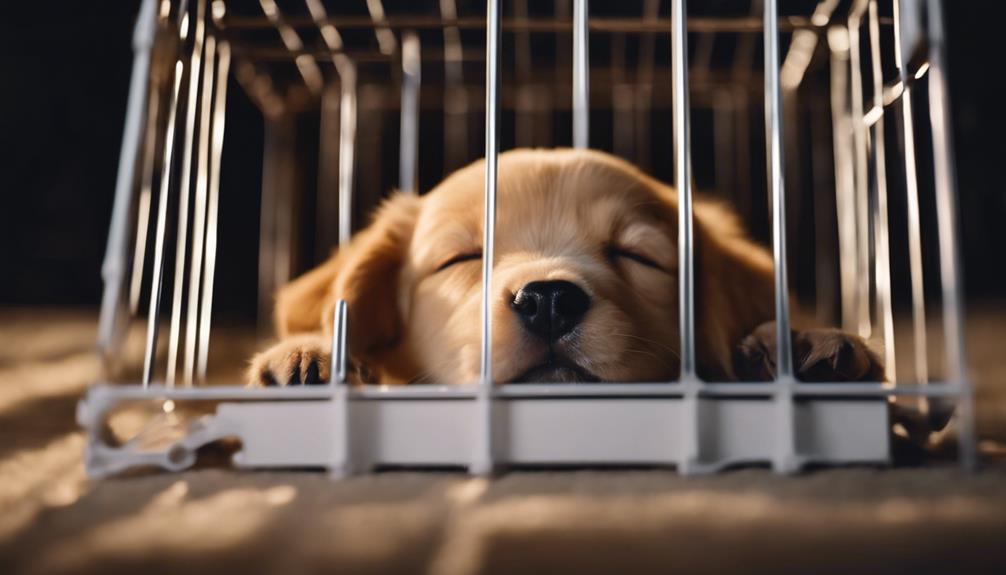
Managing whining and barking in a puppy during crate training involves understanding their communication cues and responding appropriately to encourage positive behavior.
When your puppy whines, consider if they may need to go potty, especially during the night. Follow guidelines on how long a puppy can hold it based on their age. Minimize interaction during nighttime potty breaks to avoid reinforcing crying. Comfort items like stuffed animals or thunder shirts can help soothe your puppy.
Allow your puppy some time to settle down in the crate without immediate responses. By addressing their needs calmly and consistently, you can help your puppy learn to self-soothe and feel secure in their crate, leading to quieter nights for both of you.
Consistency in Training
Establishing consistency in training is essential for instilling good habits in your puppy and ensuring a smooth integration into your family routine. To achieve this, consider the following:
- Set Clear Expectations: Define rules and boundaries early on to help your puppy understand what is expected of them.
- Maintain a Regular Schedule: Stick to a consistent feeding, potty, and bedtime routine to create a sense of predictability for your puppy.
- Use Positive Reinforcement: Reward good behavior with treats, praise, or playtime to reinforce positive habits effectively.
Crate Location and Support
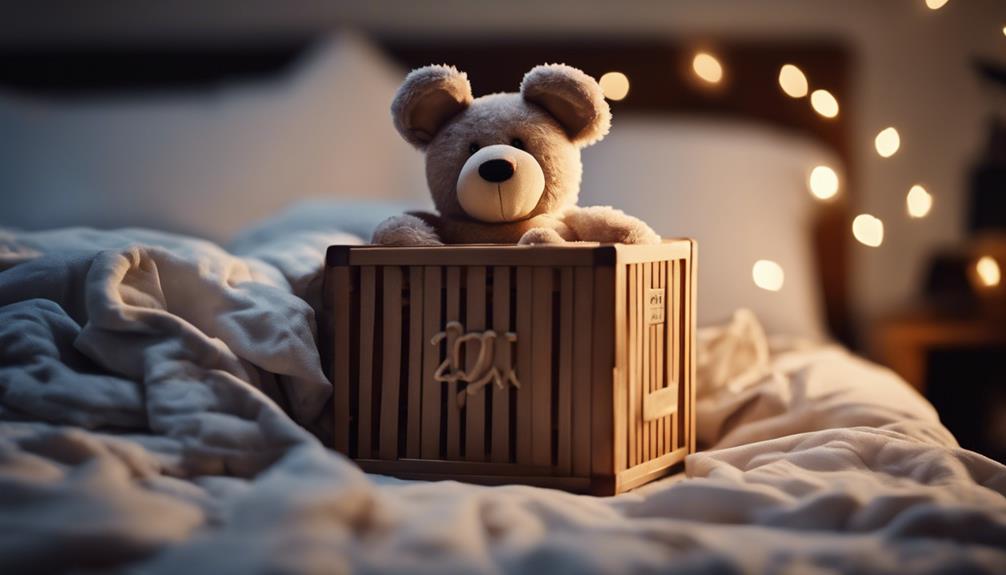
Positioning the crate in a strategic and accessible location plays a crucial role in fostering a positive crate training experience for your puppy.
Initially, place the crate next to your bed at the same level as you for comfort and reassurance. Ensure the crate is supported by a sturdy chair, table, or nightstand to prevent it from shifting. This proximity allows you to easily soothe your puppy if they become restless during the night.
As your puppy grows accustomed to the crate, gradually transition it to the final sleeping room, maintaining a consistent routine.
Reassurance Techniques
Utilizing gentle reassurance methods can aid in creating a sense of security and comfort for your puppy during crate training at night. Here are some effective techniques to reassure your puppy:
- Soft Vocal Cues: Speaking softly and reassuringly to your puppy can help them feel calm and secure.
- Calming Touch: Placing a piece of your clothing with your scent in the crate can provide comfort to your puppy.
- Background Noise: Playing soft music or white noise can help drown out unfamiliar sounds and create a soothing environment for your puppy.
These techniques can help your puppy feel safe and supported, making the crate training process smoother and more successful.
Transitioning the Crate
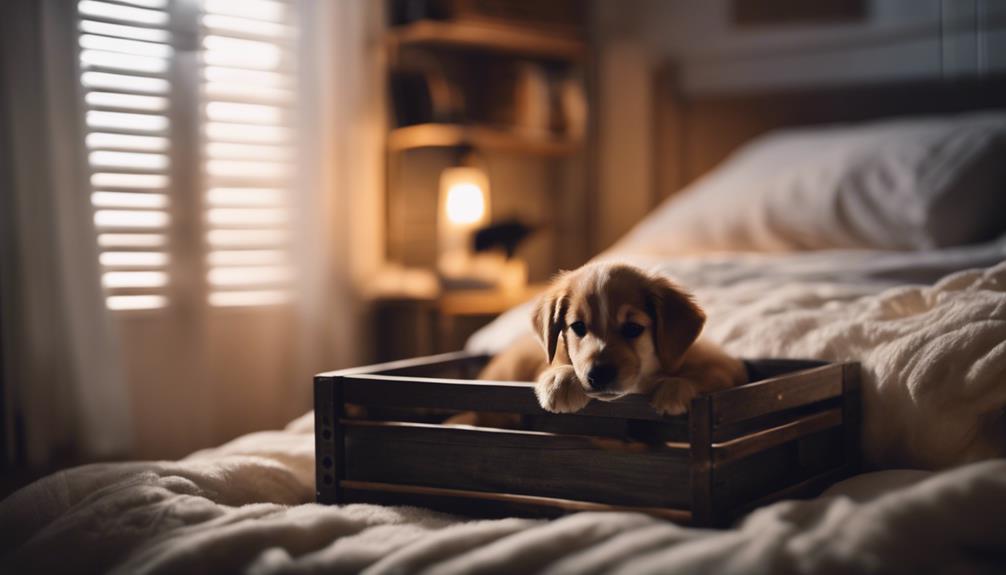
To facilitate a smooth adjustment for your puppy during crate training at night, gradually relocating the crate from its initial placement near your bed to a permanent sleeping area is a crucial step in fostering independence and comfort.
Begin by moving the crate slightly farther away from your bed each night as your puppy becomes more accustomed to sleeping alone. Transitioning the crate to the floor and eventually to its designated sleeping spot helps your puppy feel secure and confident in their own space.
This gradual shift instills a sense of routine and stability, aiding in the successful establishment of a nighttime sleeping area for your furry companion. By making this transition gradually, you can help your puppy feel safe and comfortable in their new sleeping arrangement.
Establishing a Routine
Establishing a consistent bedtime routine for your puppy is essential for promoting good sleep habits and minimizing disruptions during crate training at night. To create an effective routine, consider the following:
- Set a specific bedtime and stick to it every night.
- Engage in calming activities before bedtime, such as a short walk or gentle playtime.
- Avoid overly stimulating activities close to bedtime to help your puppy wind down.
Potty Accident Prevention
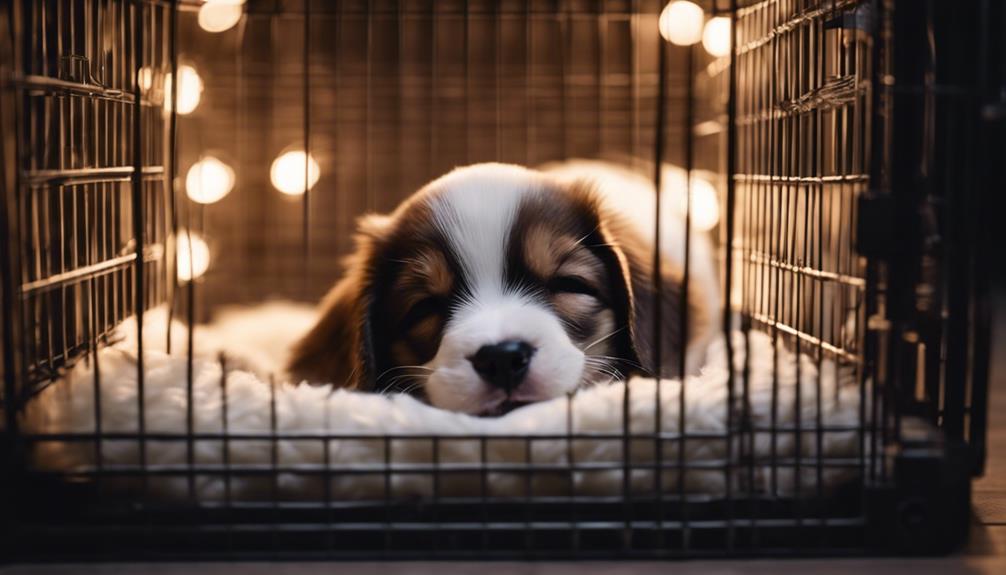
Ensuring your puppy's crate training success involves implementing effective strategies to prevent potty accidents during the night. To minimize accidents, monitor your puppy's water intake in the evening and take them out for a final potty break right before bedtime.
It's important to establish a routine for potty breaks during the night, especially for young puppies who may not be able to hold their bladders for extended periods. When your puppy signals a need to go out, respond promptly to prevent accidents in the crate.
Additionally, consider the size of the crate – it should be big enough for your puppy to stand, turn around, and lie down comfortably, but not so large that they can designate a corner for bathroom use. Consistency and patience are key in preventing potty accidents and fostering successful crate training.
Calming Bedtime Routine
Creating a serene atmosphere before bedtime can significantly contribute to fostering a sense of security and relaxation for your puppy during crate training. To establish a calming bedtime routine, consider the following:
- Consistent Schedule: Stick to a regular bedtime schedule to help your puppy anticipate rest time.
- Relaxing Activities: Engage in soothing activities like gentle petting or a short walk to help your puppy unwind.
- Quiet Environment: Ensure the sleeping area is peaceful and dimly lit to promote relaxation.
Feeding and Water Schedule
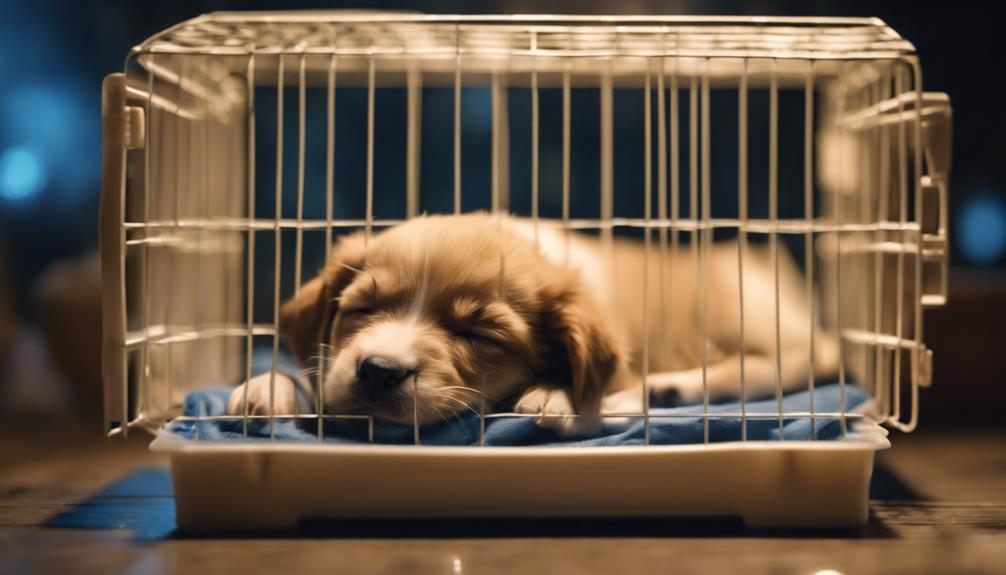
Maintaining a structured feeding and hydration regimen is essential for promoting your puppy's health and comfort during crate training at night. Consistency in meal times and water intake can help regulate your puppy's bathroom schedule and reduce nighttime disruptions. Below is a simple guide to help you establish a feeding and water schedule for your puppy:
| Feeding Schedule | Water Schedule |
|---|---|
| Morning: 7:00 AM | Morning: 6:30 AM |
| Noon: 12:00 PM | Noon: 11:30 AM |
| Evening: 5:00 PM | Evening: 4:30 PM |
Winding-Down Signals
Establish a soothing routine that signals the approaching bedtime to your puppy, aiding in a smooth transition to a restful night's sleep. To create winding-down signals for your puppy, consider the following:
- Dim the lights in the evening to encourage relaxation.
- Engage in calming activities such as gentle petting or a short walk.
- Provide a comfortable and quiet space for your puppy to settle down.
Addressing Potty Needs
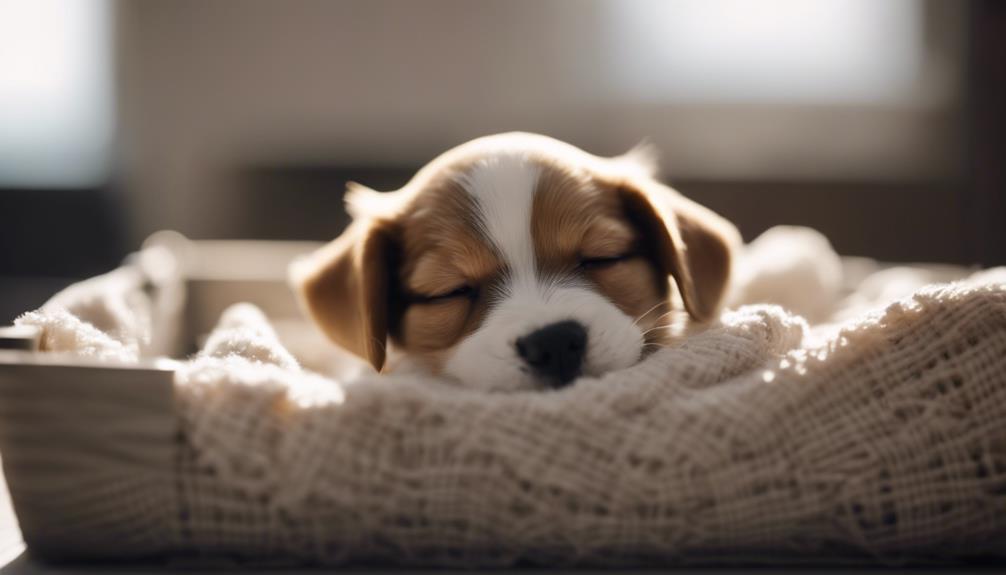
Addressing the puppy's potty needs is crucial in maintaining a successful crate training routine at night. Puppies have small bladders and may need to relieve themselves during the night. To address this, take your puppy out for a potty break right before bedtime.
Limit water intake a couple of hours before sleep to reduce the chances of accidents. If your puppy whines or shows signs of restlessness during the night, assume they need to go potty and take them out promptly.
Remember to keep these nighttime potty breaks calm and quiet to avoid stimulating your puppy too much. Consistently addressing your puppy's potty needs will help them associate the crate with a clean and comfortable space.
Comfort Items Usage
To enhance the comfort of your puppy during crate training at night, consider incorporating soothing comfort items such as stuffed animals or thunder shirts. These items can provide a sense of security and help your puppy feel more at ease in their crate. Additionally, introducing familiar scents or sounds can further aid in creating a calming environment for your furry friend.
- Stuffed animals: Placing a soft, cuddly toy in the crate can provide companionship and a sense of comfort for your puppy.
- Thunder shirts: These snug-fitting garments can help reduce anxiety in puppies by applying gentle pressure, simulating the feeling of being held or swaddled.
- Familiar scents or sounds: Introducing items with familiar scents or playing soothing music can create a relaxing atmosphere for your puppy during crate training sessions.
Allowing Settling Time
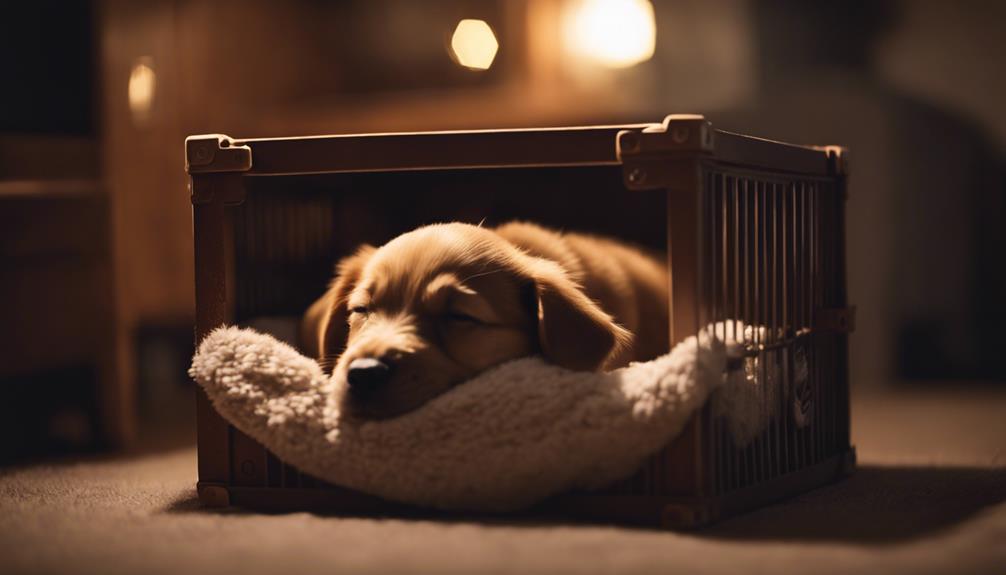
Allow your puppy the necessary time to settle down in the crate without immediate responses to encourage self-soothing behavior. By allowing your puppy this settling time, you are giving them the opportunity to learn how to self-calm and adjust to their new sleeping environment.
It's essential not to rush to your puppy at the first sign of restlessness, as this may inadvertently reinforce attention-seeking behaviors. Instead, observe from a distance and only intervene if necessary, such as when your puppy needs to go potty.
This approach promotes independence and teaches your puppy to relax on their own, leading to a more peaceful and restful night for both you and your furry companion.
Conclusion
In conclusion, crate training a puppy at night is a beneficial practice that promotes structure, routine, and healthy sleep habits.
By setting up the crate correctly, establishing a consistent bedtime routine, and addressing any whining or barking behavior, pet owners can successfully train their puppies with minimal fuss.
Consistency, patience, and positive reinforcement play key roles in helping the puppy adapt to its new sleeping environment, leading to peaceful nights for all involved.




